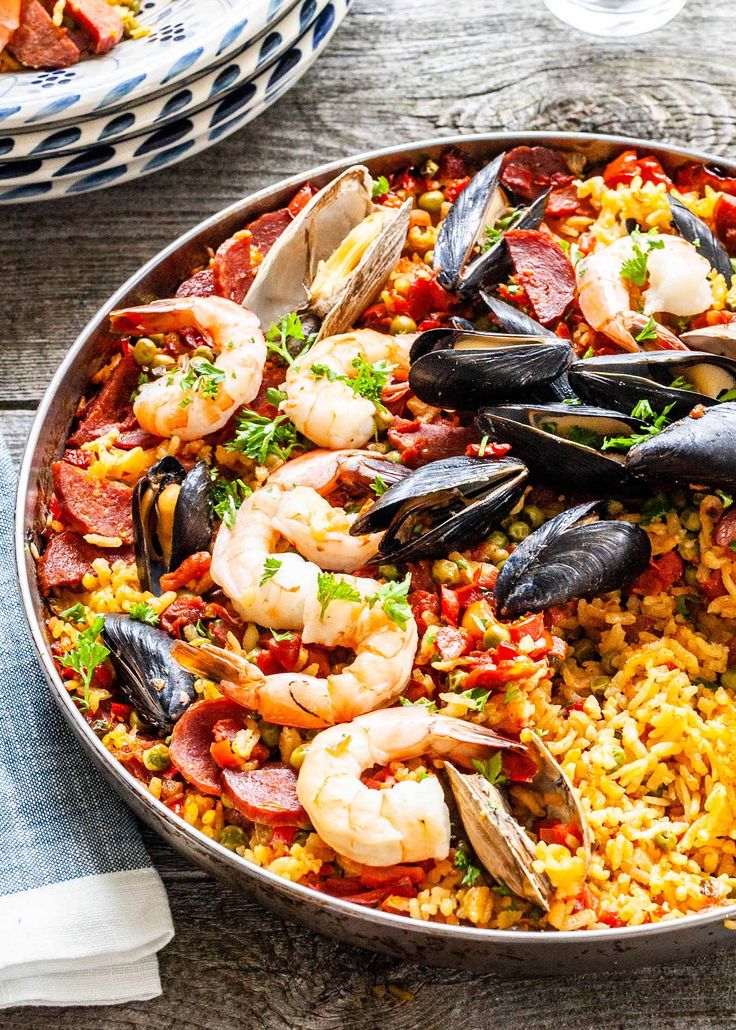Spanish Paella Recipe – Tastes Better from Scratch
You can make a delicious, authentic Paella–the most popular dish of Spain–in your own kitchen with simple ingredients like rice, saffron, vegetables, chicken, and seafood. If you love cooking International food, you will fall in love with this comforting dish!
If you love Spanish food, don’t miss my other popular recipes like Torijas and Tortilla de Patatas.
My goal with this paella recipe was to use the tutelage I received while living in Madrid to create a traditional Spanish paella that anyone can make (and without special equipment, like a paella pan). After lots of trial and error, I am so excited to share everything I know and have learned about making Paella, as authentically and practically for the home cook, as possible.
What I LOVE about this recipe:
- I learned to make it in Spain, from the woman I lived with for several months while attending school in Madrid.
She was an incredible cook and I wrote down her basic instructions for paella, in my notebook. I have since tested the recipe many times on my own to perfect the exact ingredient amounts and method for making it in my U.S. kitchen.
- No paella pan needed: You can use a regular large skillet for this recipe. See tips below.
- One-pot meal: All in one pan meals mean quicker cooking and clean-up!
- Adaptable: There are many ways of adapting this traditional paella recipe. Read on.
What is Paella?
Paella (pai·ei·uh) is a classic Spanish rice dish made with rice, saffron, vegetables, chicken, and seafood cooked and served in one pan. Although paella originates from Valencia, it’s recognized as the national food of Spain and there are several different varieties. The most common types of paella are chicken paella, seafood paella, or mixed paella (a combination of seafood, meats, and vegetables).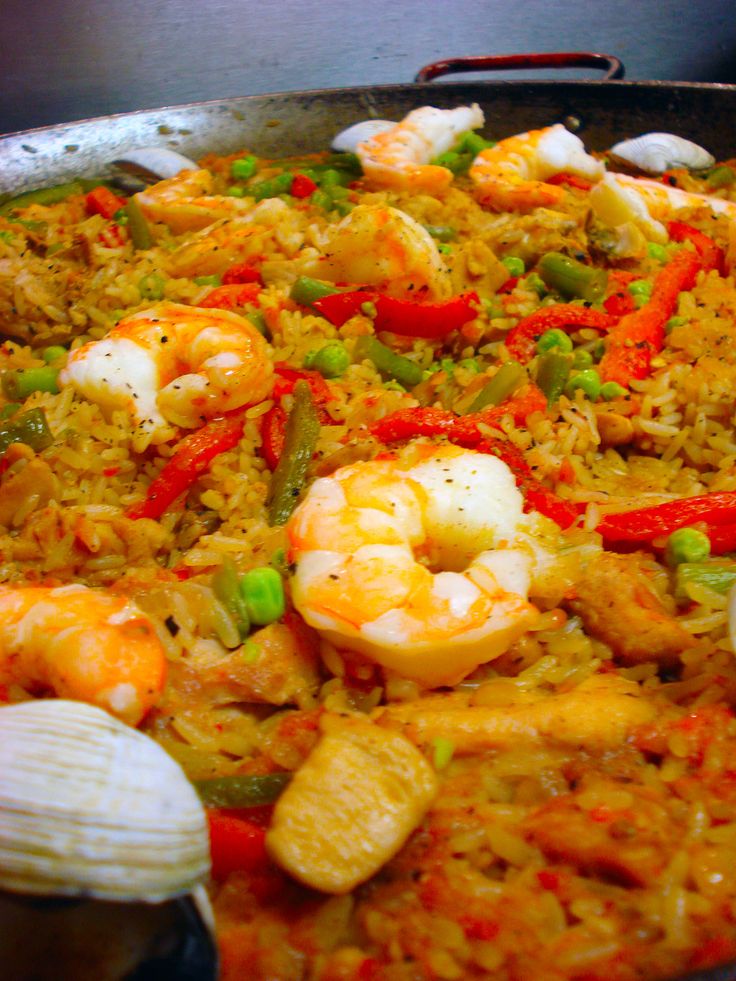
Ingredients:
The main ingredients in every paella dish are rice, saffron, chicken, and vegetables. From there, ingredients vary depending on the type of paella or region where it’s made. The ingredients in this easy paella recipe include:
- Produce: onion, bell pepper, garlic, tomatoes, parsley, frozen peas.
- Spices: bay leaf, paprika, saffron, salt and pepper.
- Saffron: this may be the most important ingredient, so it’s best to buy high quality. If your grocery store doesn’t carry it, try an International food market, or Amazon. If necessary, substitute 1 teaspoon saffron powder.
- Seafood: jumbo shrimp, mussels, calamari.
- Chicken thighs: I prefer thighs to breasts in the recipe since they don’t dry out as easily during longer cook times.
- Olive Oil: Spanish olive oil , or any good quality olive oil.
- White wine.
- Spanish Rice: See my notes below about the rice, and possible substitutions.
- Chicken Broth: Authentic paella would include making your own fish stock from the discarded shells of seafood. I usually substitute chicken broth, for convenience.
How to Make Spanish Paella:
1. Sauté: Add olive oil to a skillet over medium heat. Add onion, bell peppers and garlic and sauté until onion is translucent. Add chopped tomato, bay leaf, paprika, saffron, salt and pepper. Stir and cook for 5 minutes.
2. Add white wine. Cook for 10 minutes.
3. Add chicken & rice. Add chopped parsley and cook for 1 minute.
4. Add broth. Pour the broth slowly all around the pan and jiggle the pan to get the rice into an even layer. (Do not stir the mixture going forward!). Bring mixture to a boil. Reduce heat to medium low. Give the pan a gentle shake back and forth once or twice during cooking.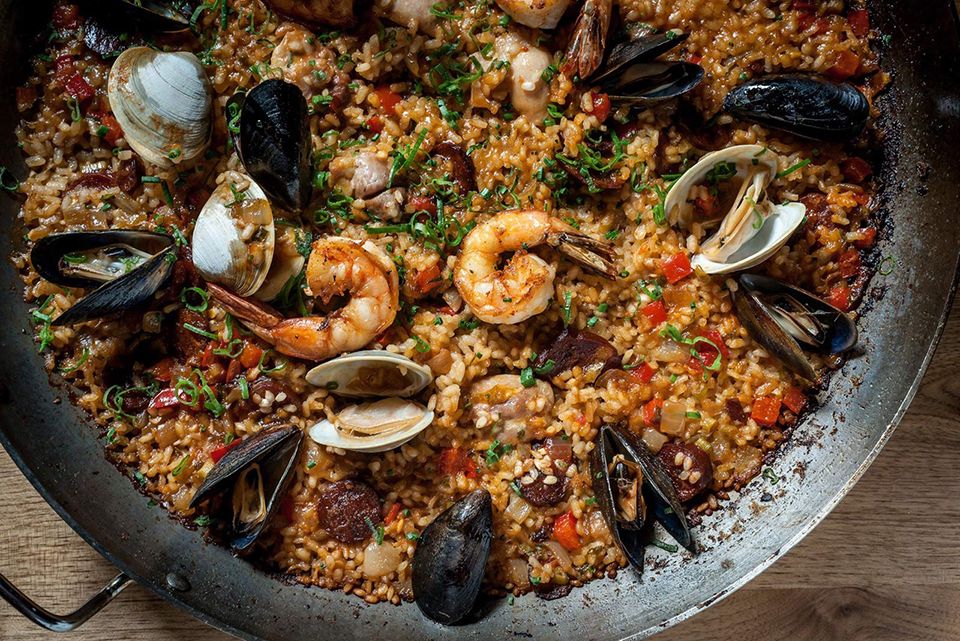
5. Cook uncovered: Cook paella uncovered for 15-18 minutes, then nestle the shrimp, mussels and calamari into the mixture, sprinkle peas on top and continue to cook (without stirring) for about 5 more minutes. Watch for most of the liquid to be absorbed and the rice at the top nearly tender. (If for some reason your rice is still uncooked, add ¼ cup more water or broth and continue cooking).
6. Cover and let rest. Remove pan from heat and cover pan with a lid or tinfoil. Place a kitchen towel over the lid and allow to rest for 10 minutes.
7. Serve. Garnish with fresh parsley and lemon slices. Serve.
Rice for Paella:
Spanish rice (also called “bomba” rice, calaspara rice, arroz redonda) is traditional in Paella, and it’s what I recommend using. It’s a short grain rice that absorbs more water than regular rice, without turning mushy. You can buy Spanish rice on Amazon, World Market or an international food market.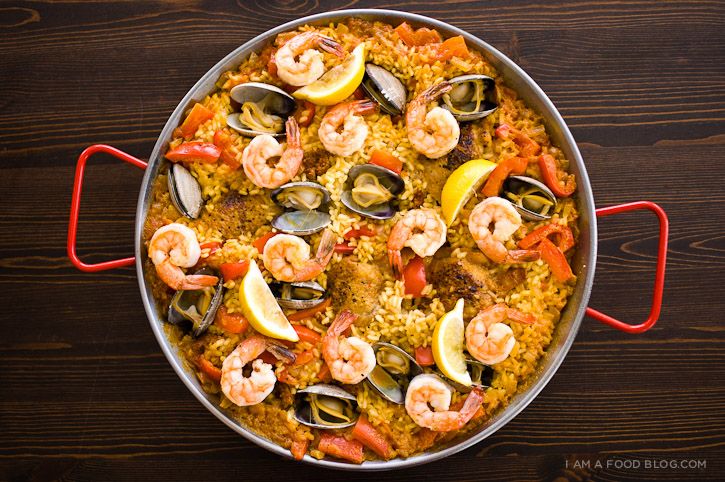
- Substitution for Spanish rice: If necessary you can substitute medium grain rice, like Calrose rice which can be found at Walmart or most grocery stores. Reduce the chicken stock in the recipe to a total of 3 ¾ cups. (I don’t recommend using Arborio rice or long-grain rice for Paella).
- Don’t wash the rice before cooking because we want to keep the outer layer of starch.
- Don’t stir the rice while cooking! Traditional paella cooks a crusty, flavorful rice layer at the bottom of the pan called the socarrat. The socarrat is a key component of authentic paella. Also, stirring the rice will make it mushy.
Seafood for Paella (What to know):
If you don’t like seafood, leave it out and substitute more chicken and vegetables. You can use any combination of your favorite seafood including clams, scallops and chopped pieces of fish. Frozen seafood is a great accessible option if you don’t live near the ocean.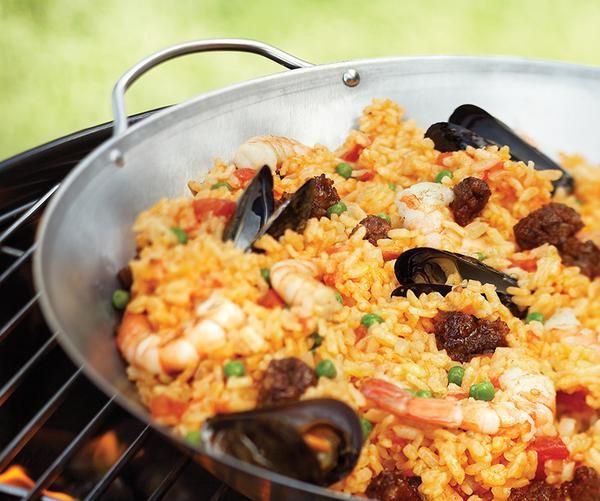
When buying fresh seafood make sure to smell it to make sure it’s fresh. It should not have a strong fishy odor. Most of the seafood used here will smell like nothing, or just like the ocean (slightly salty). Be sure to clean it properly (remove “beards” from mussels, if necessary).
Do I need a paella pan?
No, you can us a regular large skillet to make Paella (I use a 12×2 inch skillet and this recipe fills it to the brim). Traditional paella is cooked in a large paella pan because it allow the rice to be spread out into a thin layer and cook more evenly.
Adaptations:
- Use different rice: if needed, you can substitute a medium grain rice, like Calrose rice which can be found at Walmart or most grocery stores. Reduce the chicken stock in the recipe to a total of 3 ¾ cups.
(Long grain rice or arborio rice are not good substitutes for paella.)
- Substitute pork: Substitute boneless pork loin, cut into ½ inch cubes. Brown the pork pieces in hot oil as step one in the recipe. Then set it aside as you sauté the vegetables. Add the pork back to the pan in step 3 before boiling.
- Substitute Turkey or rabbit: Brown the meat in hot oil as step one in the recipe. Then set it aside as you sauté the vegetables. Add the meat back to the pan in step 3 of the recipe, before boiling.
- Substitute chorizo: Add 1 chorizo sausage cut into ½ inch discs. Brown the sausage in hot oil as step one in the recipe. Then set it aside as you sauté the vegetables. Add chorizo back to the pan in step 3 of the recipe, before boiling.
- Vegetarian Paella: Omit the meat and seafood and add extra vegetables, like artichoke, green beans, mushroom, olives and asparagus. Add vegetables in step one of the recipe along with the bell peppers.
- Valenciana Paella: this version of paella is often made with rabbit, chicken, artichokes and green beans.
You can also FOLLOW ME on FACEBOOK, TWITTER, INSTAGRAM and PINTEREST for more great recipes!
Recipe
4.91 from 590 votes
Spanish Paella
You can make a delicious, authentic Paella–the most popular dish of Spain–in your own kitchen with simple ingredients like rice, saffron, vegetables, chicken, and seafood.
Prep 20 mins
Cook 40 mins
Total 1 hr
Save Recipe
-
14 inch skillet
-
paella pan
- ▢ 1/4 cup Extra virgin olive Oil (Spanish EVOO if you have it)
- ▢ 1 Onion , diced
- ▢ 1 bell pepper , diced (I like to use ½ red and ½ green)
- ▢ 4 cloves Garlic
- ▢ 3 roma tomatoes , very finely diced (or 8 oz.
tomato sauce)
- ▢ Bay leaf
- ▢ 1 teaspoon paprika , sweet or smoked
- ▢ 1 pinch saffron threads*
- ▢ Salt and pepper
- ▢ ¼ cup white wine
- ▢ 4 boneless , skinless chicken thighs , cut into pieces*
- ▢ ¼ cup fresh chopped parsley chopped, divided
- ▢ 2 cups Spanish Rice*
- ▢ 5 cups Chicken Broth*
- ▢ 1/2 cup frozen peas
- ▢ ½ lb Jumbo Shrimp or prawns , about 12 – peeled, tail on
- ▢ 1/2 lb Mussels (about 10-12), cleaned properly (beards off)
- ▢ 8 oz calamari rings
- ▢ Lemons , for garnish
-
*Please note, this is my version of Paella Mixta I learned to make while living in Madrid, Spain. I’ve simplified the recipe as best I could for anyone to be able to make without a special pan or equipment.
There are MANY variations to Paella so please be respectful that my authentic recipe may be different from yours!
-
Add olive oil to a skillet over medium heat. Add the onion, bell peppers and garlic and cook until onion is translucent. Add chopped tomato, bay leaf, paprika, saffron salt and pepper. Stir and cook for 5 minutes. Add white wine and cook for 10 minutes. Taste and add salt if needed.
-
Add chicken pieces, 2 tablespoons chopped parsley and rice to the pot. Cook for 1 minute.
-
Pour the broth slowly all around the pan and jiggle the pan to get the rice into an even layer. (Do not stir the mixture going forward!).
-
Bring mixture to a boil. Reduce heat to medium low. Give the pan a gentle shake back and forth just once or twice during cooking. (We don’t ever stir the rice, so that a crispy crust forms at the bottom, called a socarrat).
-
Cook for about 15-18 minutes (uncovered), then nestle the shrimp, mussels and calamari into the mixture, sprinkle peas on top and continue to cook (without stirring) for about 5 more minutes.
Watch for most of the liquid to be absorbed and the rice at the top nearly tender. (If for some reason your rice is still not cooked, add ¼ cup more water or broth and continue cooking).
-
Remove pan from heat and cover pan with a lid or tinfoil. Place a kitchen towel over the lid and allow to rest for 10 minutes.
-
Garnish with fresh parsley and lemon slices. Serve.
*Rice: Spanish rice (also called “bomba” rice, calaspara rice, arroz redonda) is traditional in Paella, and it’s what I recommend using. (If your grocery store doesn’t carry it, try Amazon, World Market, or an International food market). If necessary you can substitute medium grain rice, like Calrose rice which can be found at Walmart or most grocery stores, and reduce the broth to 3 ¾ cups. (I don’t recommend using Arborio rice or long-grain rice for Paella).
*Meat: you could also use pork, turkey, rabbit, chorizo or a combination.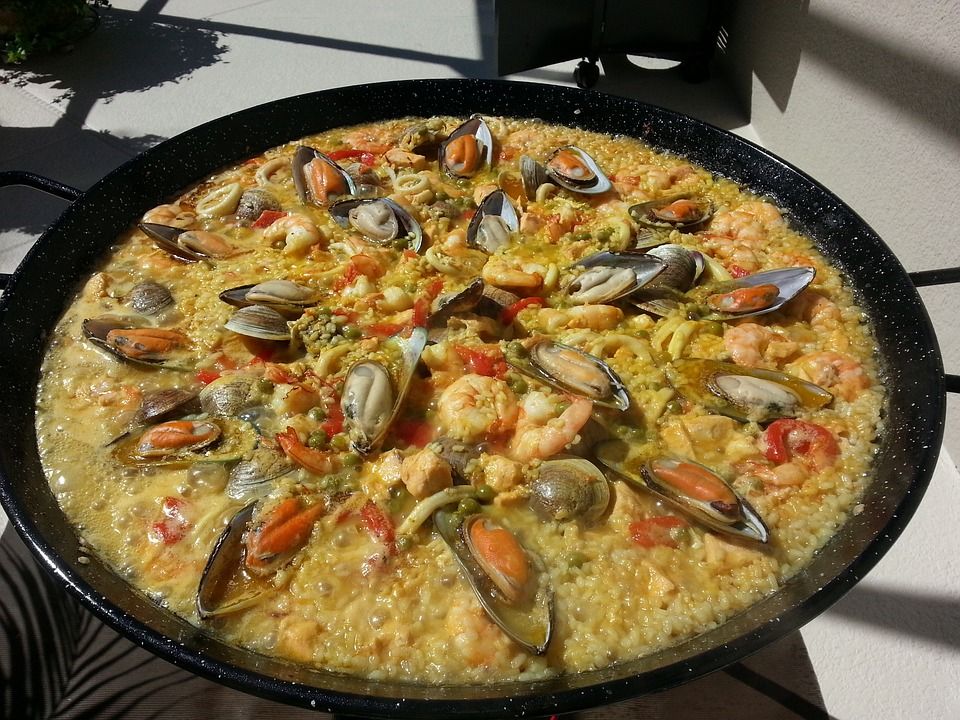
*Broth: Authentic paella would include making your own fish stock from the discard shells of seafood. I usually substitute chicken broth for convenience.
*Seafood: If you don’t like seafood, leave it out and substitute more chicken or vegetables. You can use any combination of your favorite seafood including clams, scallops and chopped pieces of fish. Frozen seafood is a great accessible option if you don’t live near the ocean. (Costco sells a great mixed seafood bag in their freezer section with shrimp, mussels, clams, scallops, and calamari.) Be sure to thaw frozen seafood in the fridge overnight before using.
If buying fresh seafood, smell it to make sure it’s fresh. It should not have a strong fishy odor. Most of the seafood used here will smell like nothing, or just like the ocean (slightly salty). Be sure to clean it properly (remove “beards” from mussels, if necessary).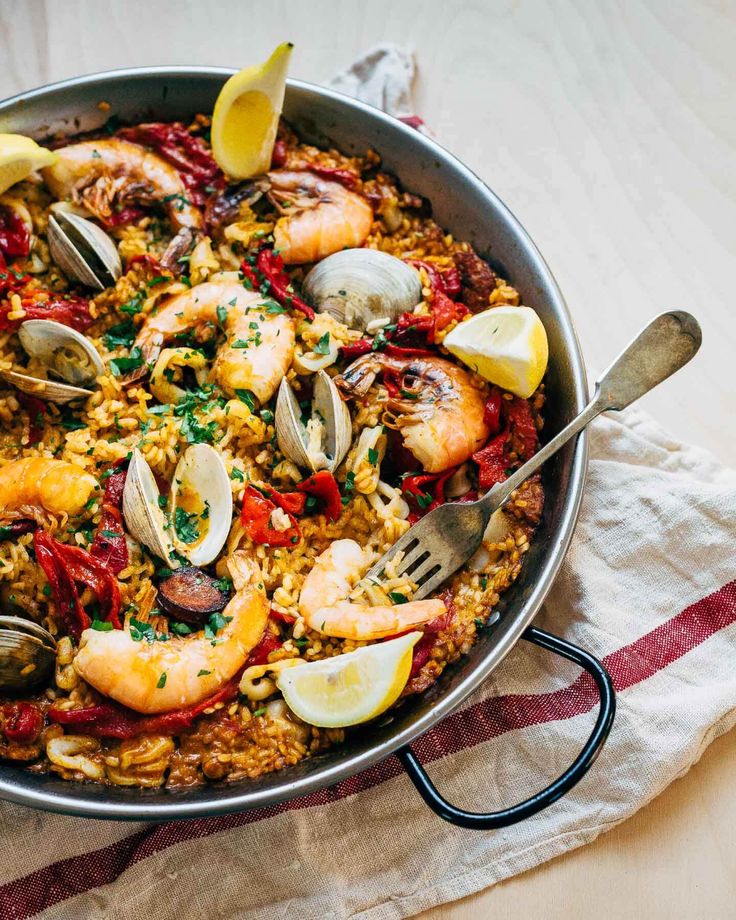
*Saffron: this may be the most important ingredient, so it’s best to buy high quality. If your grocery store doesn’t carry it, try an International food market, or Amazon. If necessary, substitute 1 teaspoon saffron powder.
Adaptations:
- Use different rice: if needed, you can substitute a medium grain rice, like Calrose rice which can be found at Walmart or most grocery stores. Reduce the chicken stock in the recipe to a total of 3 ¾ cups.
- Substitute pork: Substitute boneless pork loin, cut into ½ inch cubes. Brown the pork pieces in hot oil as step one in the recipe. Then set it aside as you sauté the vegetables. Add the pork back to the pan in step 3 before boiling.
- Substitute Turkey or rabbit: Brown the meat in hot oil as step one in the recipe. Then set it aside as you sauté the vegetables.
Add the meat back to the pan in step 3 of the recipe, before boiling.
- Substitute chorizo: Add 1 chorizo sausage cut into ½ inch discs. Brown the sausage in hot oil as step one in the recipe. Then set it aside as you sauté the vegetables. Add chorizo back to the pan in step 3 of the recipe, before boiling.
- Vegetarian Paella: Omit the meat and seafood and add extra vegetables, like artichoke, green beans, mushroom, olives and asparagus. Add vegetables in step one of the recipe along with the bell peppers.
- Valenciana Paella: this version of paella is often made with rabbit, chicken, artichokes and green beans.
Calories: 535kcalCarbohydrates: 59gProtein: 37gFat: 15gSaturated Fat: 3gCholesterol: 260mgSodium: 1159mgPotassium: 805mgFiber: 3gSugar: 3gVitamin A: 1408IUVitamin C: 58mgCalcium: 125mgIron: 4mg
Did You Make This Recipe?
Tag @TastesBetterFromScratch on Instagram with #TastesBetterFromScratch!
@TastesBetterFromScratch
HAVE YOU TRIED THIS RECIPE?!
RATE and COMMENT below! I would love to hear your experience.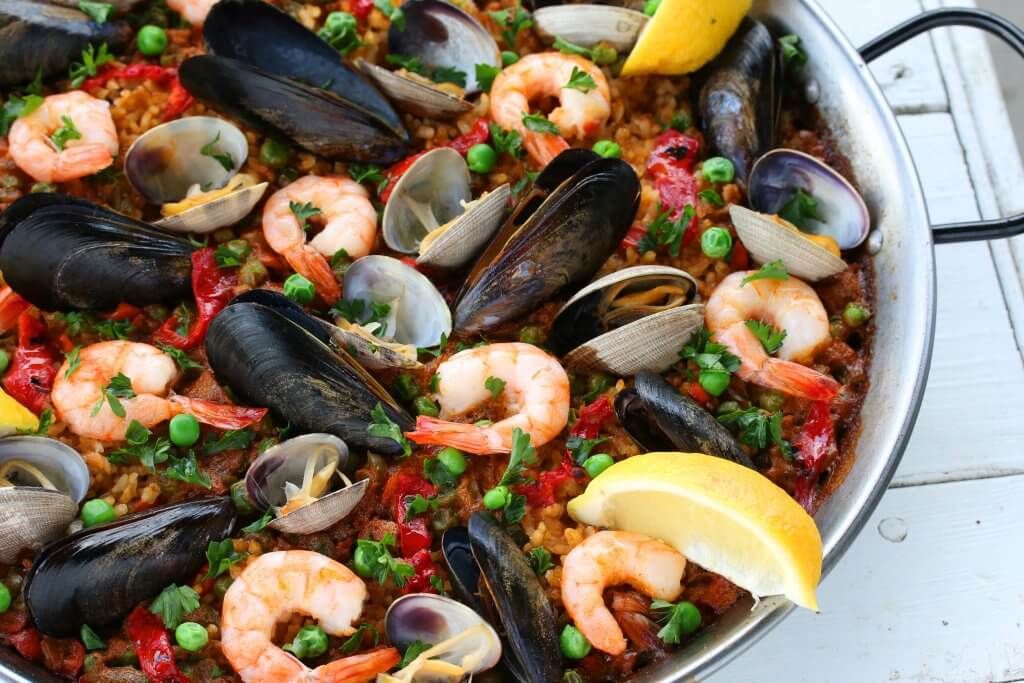
Related Posts
Original Post
Updated
Categories
About The Author
Lauren Allen
Welcome! I’m Lauren, a mom of four and lover of good food. Here you’ll find easy recipes and weeknight meal ideas made with real ingredients, with step-by-step photos and videos.
Learn More
Best Paella Ever · i am a food blog
Paella has bits of everything I love: rice, seafood, and most importantly socarrat: crispy crunchy toasted rice bits.
Have you ever been obsessed with a dish even though you’ve never eaten it? For me, that dish was paella. It was one of those food bucket list items – I don’t remember how or why I became so obsessed with having paella from its birthplace of Valencia, but I’m pretty sure it has something to do with the fact that paella is so pretty and such an iconic dish. It’s so iconic that people around the world think of it as the quintessential Spanish dish, even though it’s actually more Valencian.
A couple of years ago Mike and I went to Valencia and the first thing we ate was paella! We literally got off the train and went to a paella restaurant. On the way there, there were a bunch of Valencian orange trees that had some pretty tempting looking oranges but apparently the orange trees that line the streets of Valencia are not the same sweet ones that they use for juice. Anyway, the paella in Spain was as good as I imagined. So good that all of our meals in Valencia were either paella or Spanish churros dipped in chocolate.
The paella was all things good: juicy seasoned meats, tender-crisp beans, and the best part, saffron scented rice with crispy toasty rice bits. It was a dream come true.
What is paella?
Paella, pronounced pay-EH-yah! is a rice dish made in a shallow, wide pan over an open fire. Paella means “frying pan” in Valencian. Traditionally, paella includes short grain rice, green beans, rabbit, chicken, and saffron, but nowadays there are a huge number of variations, from seafood to vegetarian.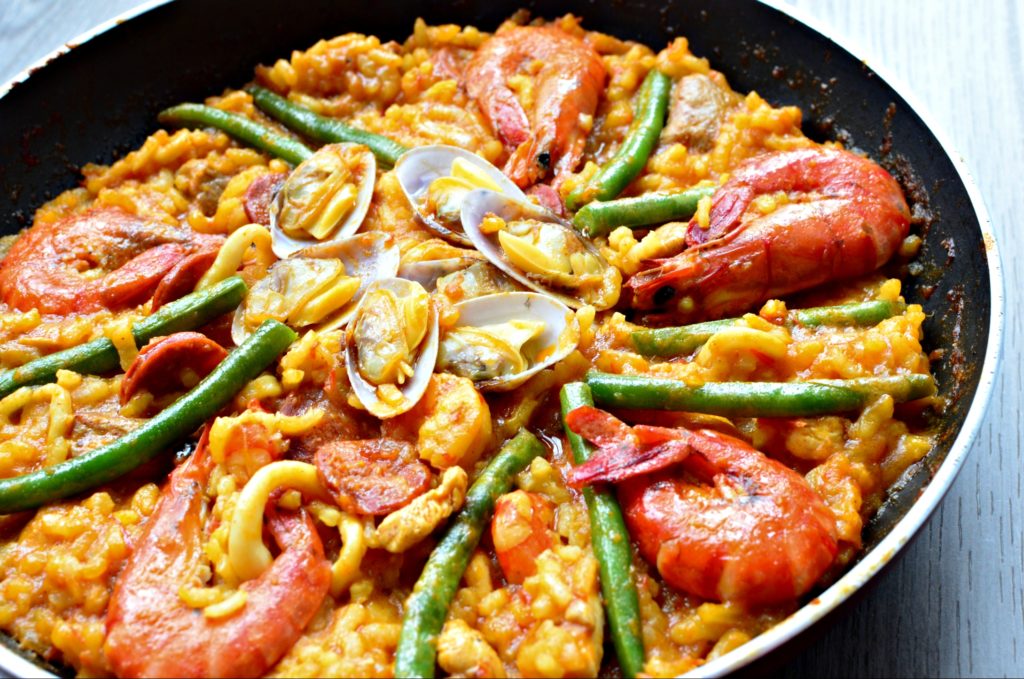
How to make paella
- Soak the saffron. This will release both color and aroma. Pop some saffron into a small bowl with hot water and set aside.
- Sear the proteins. Heat up some olive oil in your paella pan over medium high heat and give your proteins a quick sear: the chicken goes in skin side down and the chorizo gets browned. Shrimp gets a quick toss in before being removed so it doesn’t over cook.
- Sweat the aromatics. Add the onions, garlic, tomatoes, and paprika and cook, stirring, until soft and fragrant.
- Add the liquids. Carefully add chicken stock and the saffron water and bring everything to a boil. Flip the chicken skin side up so it’s pretty.
- Add the rice. Time to sprinkle in the rice! Try to add it in a thin, even layer and use a spoon to spread it out if you need to.
Let everything come to a simmer and cook, uncovered until the rice absorbs almost all the liquid.
- Add the seafood. Nestle in the clams and add the shrimp back on top.
- Cook on low until the clams open up and the rice is al denote.
- Socarrat time! Turn the heat up to high for 1-2 minutes to create a crispy toasty crunchy rice crust.
- Rest and enjoy. Cover the paella with some foil and let rest for 5 minutes before enjoying.
Paella Ingredients
Rice
Because paella is truly all about the rice, the rice is the most important ingredient. Bomba rice, from Spain, is the best choice. It absorbs 3 times as much liquid than regular rice giving it 3 times as much flavor when all the liquid is absorbed. Plus cooked right, it stays firm and al dente. You can usually find bomba rice at Whole Foods or online.
Smoked Spanish Paprika
Smoked paprika comes in sweet and bittersweet, go for sweet smoked Spanish paprika.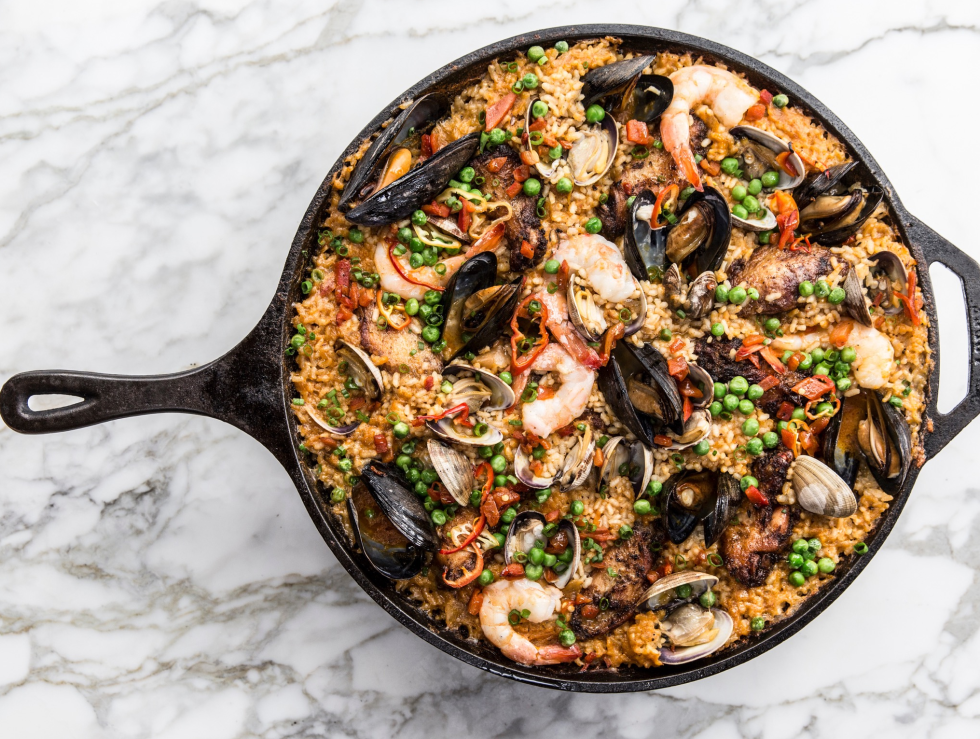
Protein
There’s a lot of controversy about what kind of protein goes into paella. If you’re not super concerned about authenticity you can customize your paella and put anything you want it. If you’re going with chorizo try to get a Spanish chorizo, which is dried and cured. But if you only have Mexican chorizo available, I think that’s okay too. Purists say that chorizo will overwhelm the other flavors, but we’ve had multiple paella in Valencia with (and without) chorizo, so it’s a personal choice. Other proteins you can use include chicken, pork, seafood, or really, anything you can dream of.
Vegetables
Most paella has vegetables in it, especially the paella we had while we were in Valencia. Usually it’s some sort of green bean, a variety that isn’t so common here in North America. You can sub in other green beans, add peppers, asparagus, artichokes, peas, olives, beans, chickpeas, really, it’s like the proteins, go wild!
Stock
A nicely seasoned stock as this is what’s going to add flavor to the insides of your bomba rice.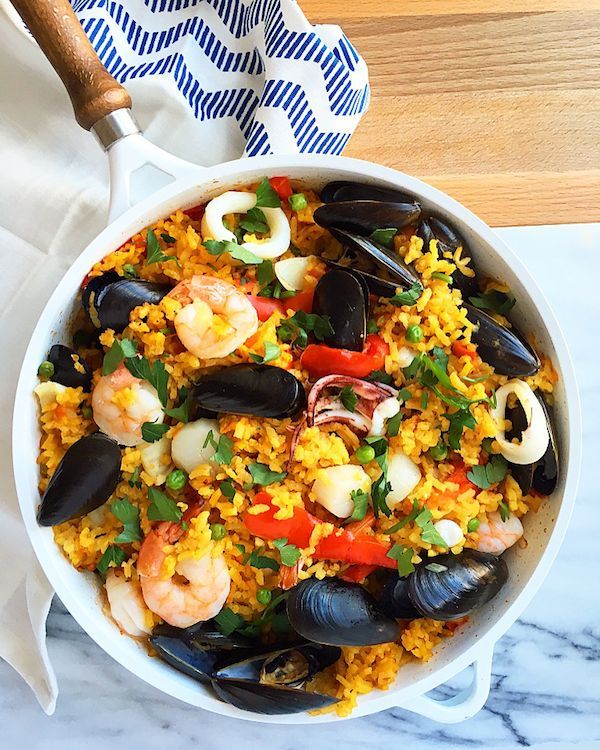
Saffron
Saffron is what gives paella its gorgeous golden hue. The orange-red threads are earthy, floral, and add a distinct flavor. Saffron is one of the most expensive spices in the world. You only need about 1/2 teaspoon but it definitely adds to the overall flavor, so don’t skip out on it. Look for saffron threads that are deep red-orange and evenly colored. Saffron is sold in most large grocery stores and specialty food stores and of course, online.
Paella pan
If you want the all important toasty rice bits, or socarrat, you’re going to need a paella pan. The width of a paella pan helps with rice distribution, ensuring that the rice cooks in a thin layer. A pan that feeds two is generally about 10-12 inches and a pan that serves eight is about 18 inches.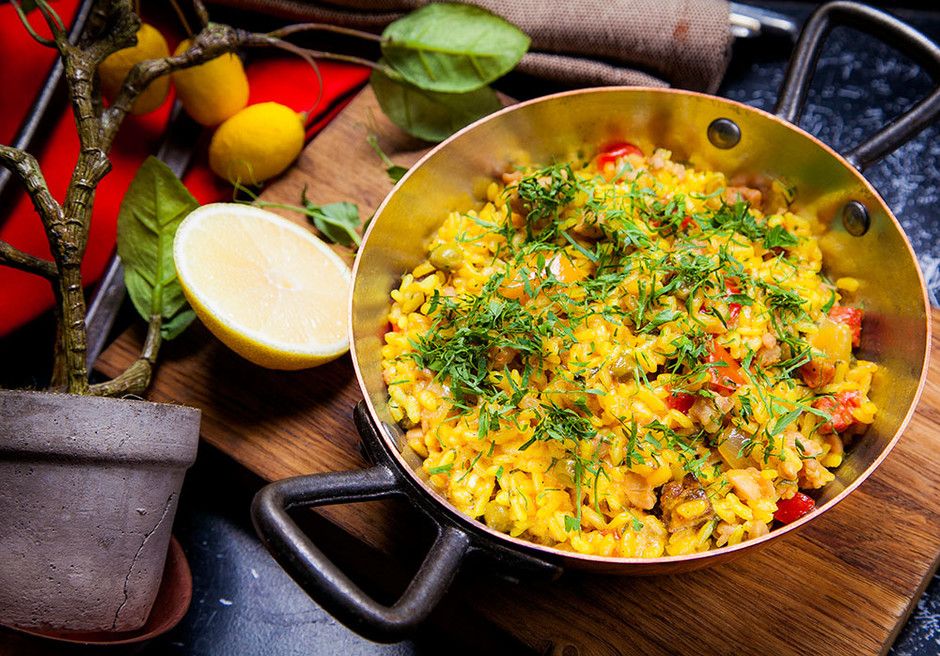
The wider the pan, the more people it feeds. They even have pans that are 4 feet wide! Years ago, around Christmas, Mike and I were in London and we saw two giant paella pans at Covent Garden. The saffron deliciousness wafting through the chilly air was so tempting so we decided to join the huge queue for a taste. I’m sure Hola Paella (now closed forever) wasn’t the most authentic paella in London, but it attracted a lot of attention and was a perfect snack to warm us up on a cold day.
What if I don’t have a paella pan?
If you’re wondering, can I use a cast iron skillet to make paella, the answer is yes! As long as you’re using the right rice, you can definitely use a cast iron skillet. Cast iron skillets are somewhat wide and conduct heat well, making them great for making paella. Use the biggest and widest cast iron pan you have so you can spread your rice out.
Paella in a frying pan
If you have a craving for paella and you don’t have a paella pan or a cast iron pan you can make it in a frying pan. Spanish people might look down on you, but hey, you do you! I’ve definitely made paella in a frying pan in a pinch and it tastes good. You can use a non-stick or regular frying pan but if you’re using non-stick, make sure you don’t go too high on the heat. It really shouldn’t be a problem, especially with paella since you don’t use a huge amount of high heat anyway – keep it to medium high. If you’re looking for socarrat in a regular frying pan, my tip is keep it on low heat for a long time, until the moisture cooks out and you get crispy bottoms. If you are going to try this in a frying pan, I recommend halving it because the recipe as per below will not fit in your standard 12 inch frying pan.
What rice should I use?
Paella should be made with Bomba or Calasparra rice, medium grain rices grown in Spain. Spanish rice is chubby and round, ideal for absorbing large amounts of liquid while still staying somewhat firm.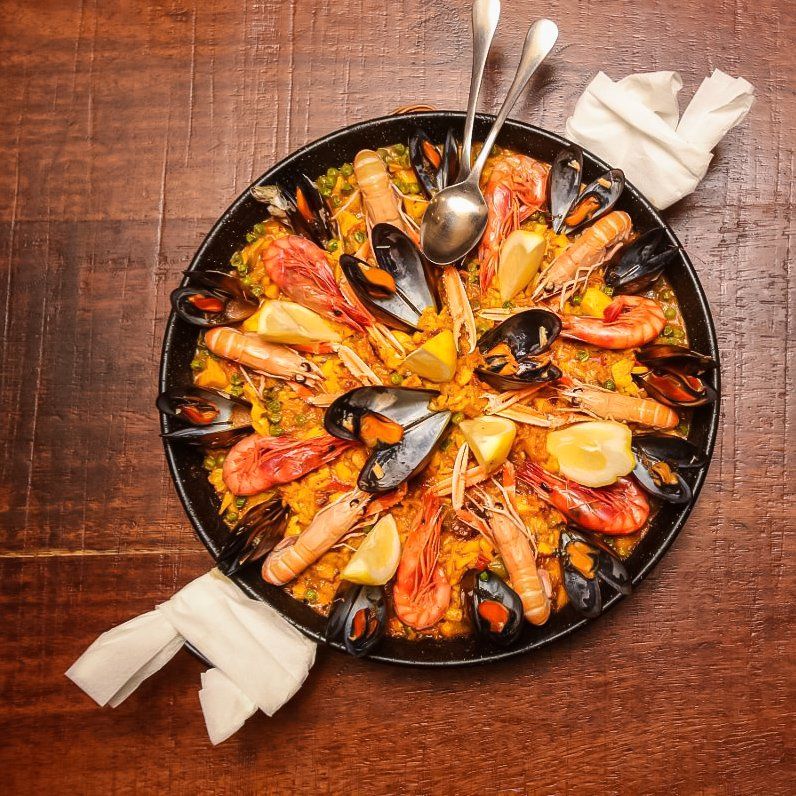
The rice really is the best part of a paella. I can eat loads and loads of that smoky, saffron flavoured rice and I have. I made a giant pan for Mike, myself and a good friend thinking there would definitely be leftovers (I used a pan that serves 6-8), but the three of us polished it off in one sitting. We totally fell into simultaneous food comas afterwards, but it was worth it. The best part was that there was more than enough socarrat to go around.
What is socarrat?
Socarrat is the essential layer of crispy crunchy toasted rice at the bottom of the pan when you cook your paella just right. Most people consider it the best parts. It’s caramelized and toasty and nutty and has all the flavors of paella concentrated.
Paella FAQ
What are the different kinds of paella?
- Valencian: The classic Valencia version with rabbit, chicken, lima beans, long beans, snails, and rosemary.
- Seafood/paella de marisco: A seafood version with no meat. It tends to be a bit more liquidy because seafood releases a lot of delicious juices. It usually has prawns, mussels, calamari, and clams.
- Mixed/mixta paella: A mix between Valencian and marisco with meat and seafood. It’s the most popular of all.
- Paella negra: Immediately recognizable with it’s inky black rice. It’s made with squid ink and is a Spanish favorite.
- Vegetarian/paella vegetariana: Loads of vegetables like artichokes, lima beans, and red and greens peppers. Sometimes you’ll find chickpeas and potatoes too.
Should you presoak the rice?
There’s no reason to soak the rice. Soaking the rice will make it more likely to be overcooked and mushy.
Do you stir while cooking?
Nope, no stirring required. Paella is not risotto and stirring will give your rice a creamy texture instead of the crispy socarrat you’re looking for.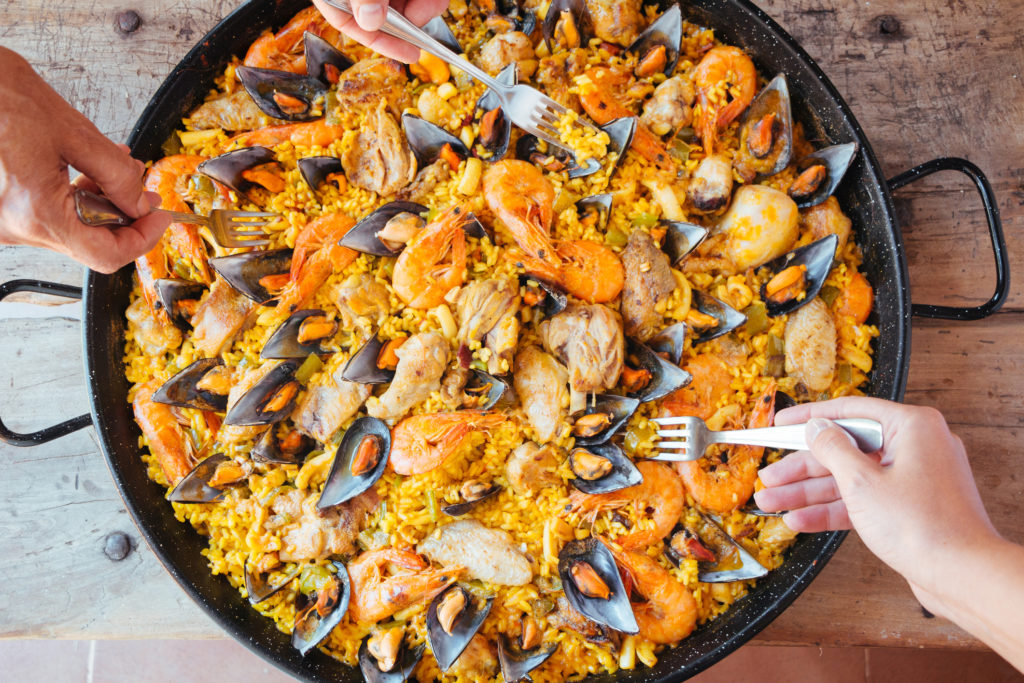
Do you cover the pan when cooking?
Unlike other rice dishes, you don’t need to cover the pan. The rice can only reach its signature al dente texture if the moisture can escape. This also makes the best the crispy socarrat.
What is paella sauce?
In Valencia, no paella is complete without a side of paella sauce or garlic aioli. The creamy, garlicky sauce is reminiscent of mayo and goes perfectly with the smoky, flavorful rice. To make garlic aioli, place 1 cup neutral oil, 1 egg yolk, 1 tbsp dijon, 2 tsp lemon juice, and 1 clove garlic into an immersion blender cup. Use an immersion blender and blend until combined and thick. Season with salt to taste.
How to reheat
The best way to reheat paella is in a pan on the stove top. Take the leftovers out of the fridge and let it come to room temp for about 30 minutes before you reheat. Heat a bit of oil in a frying pan over medium heat, then spread out the paella. Let it crisp, stirring occasionally until it is heated through.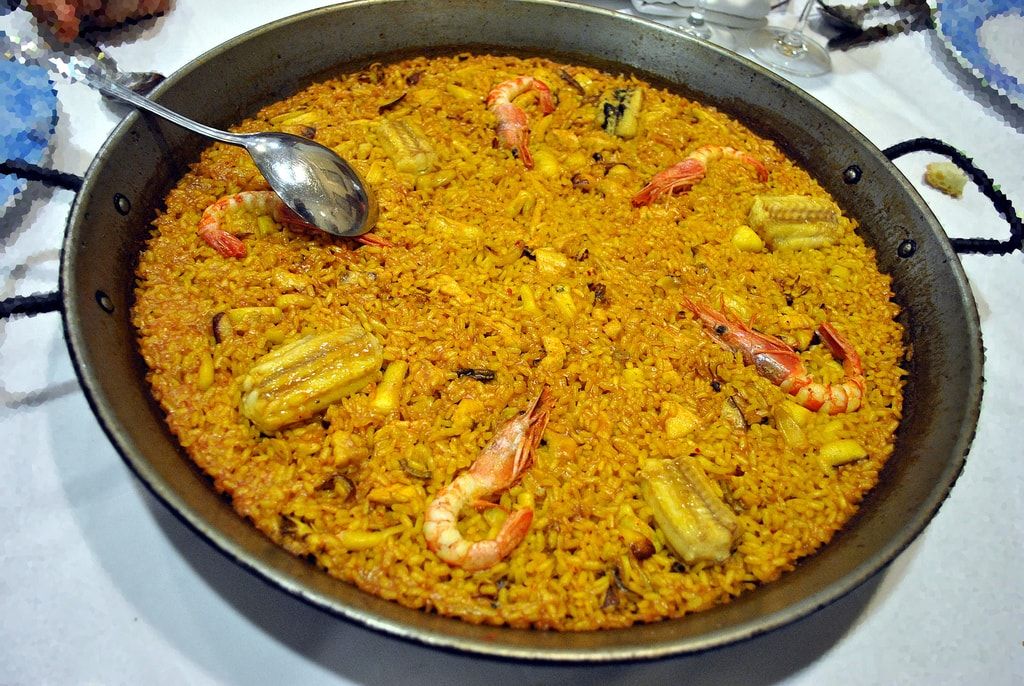
What else can I use a paella pan for?
You can use it for cooking anything that will do well with a wide, flat cooking surface. It’s perfect for searing meats, using as a roasting pan, or even stir-fry.
I hope you guys give this recipe a try.
smoky saffron rice and crispy bits forever,
xoxo steph
Paella Recipe
Paella even has its own emoji!
Serves 6
4.71 from 106 votes
Prep Time 15 mins
Cook Time 45 mins
Total Time 1 hr
- 30 threads saffron lightly crushed, about 1/2 tsp
- 1/4 cup neutral oil high heat such as grapeseed preferred
- 2 links Spanish chorizo sliced
- 4 bone in skin on chicken thighs
- 10-12 large shrimp peeled and deveined
- 1 small onion minced, about 1 cup
- 3 cloves garlic crushed
- 3 medium tomatoes diced or grated, about 2 cups, see notes
- 1 tbsp smoked paprika
- 6 cups chicken broth no sodium preferred
- 2.
5 cups bomba rice
- 1 red or orange pepper sliced into 1″ strips
- 12 clams
-
medium-sized paella pan
-
Stir the saffron into 1⁄4 cup hot water in a small bowl and let bloom for 15 minutes.
-
In a 16″–18″ paella pan, heat the oil over medium-high heat. Add the chorizo and the chicken, skin side down. Add the the shrimp and cook, flipping occasionally, until browned, about 5 minutes, then transfer the shrimp to a plate, leaving the meats to sear in the pan.
-
Add the onions, garlic, tomatoes, and paprika and cook, stirring often, until the onions soften, about 6 minutes. Add the saffron and 4 cups of chicken stock. Flip the chicken so it’s skin side up and bring everything to a boil over high heat.
-
Sprinkle in the rice, distributing evenly, then add the peppers on top. Cook, uncovered, without stirring, until rice has absorbed most of the liquid, about 12-15 minutes.
If the pan is larger than the burner, rotate it every two minutes to evenly distribute the heat. Once the stock is low enough, add the remaining 2 cups chicken stock.
-
Reduce heat to low, and top with the cooked shrimp. Nestle in the clams, hinge side down. Continue to cook, without covering or stirring, until the clams opened and the rice absorbs the liquid and is al dente, 5–10 minutes more. Turn heat to high for 1-2 minutes to create the socarrat. Remove pan from heat, cover with aluminum foil, and let sit for 5 minutes before enjoying.
Paella is totally customizable so feel free to make this dish vegetarian, all seafood, or all meats.
You also can grate the tomatoes on the largest holes of a box grater. Be careful and discard the skin afterwards.
Nutrition Facts
Paella Recipe
Amount Per Serving
Calories 589
Calories from Fat 158
% Daily Value*
Fat 17.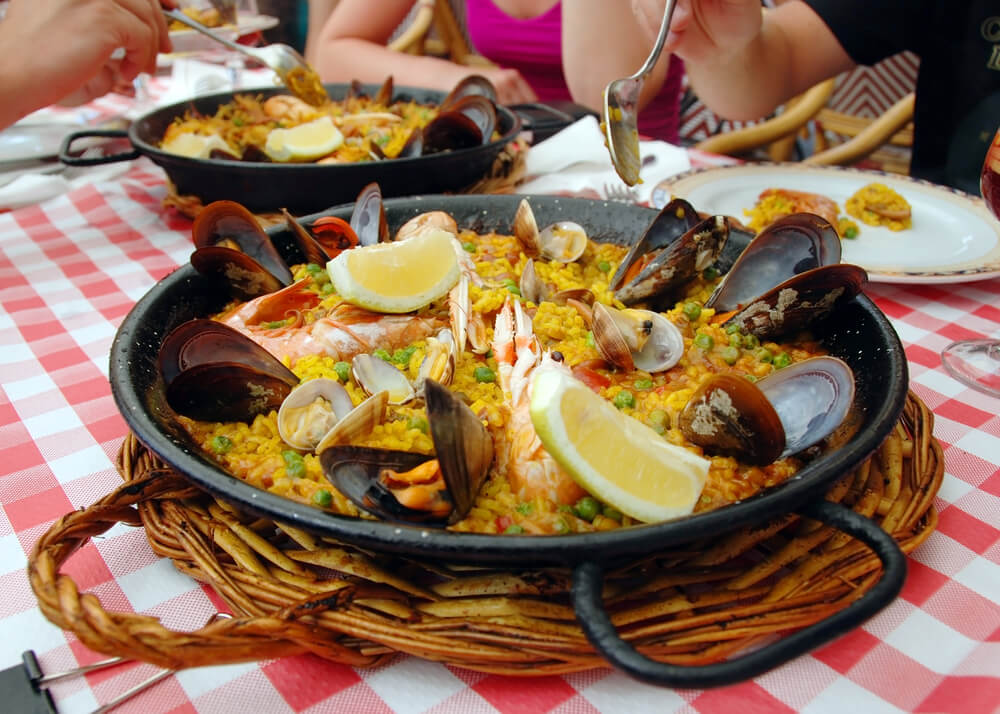
Saturated Fat 2.5g16%
Cholesterol 112mg37%
Sodium 353mg15%
Potassium 368mg11%
Carbohydrates 83.8g28%
Fiber 2.8g12%
Sugar 3.1g3%
Protein 26.2g52%
* Percent Daily Values are based on a 2000 calorie diet.
The Best Paella in Barcelona – FUNBCN
Today I’m going to tell you about paella, Thursdays, the rules of proper eating “rice queen” and the best restaurants in Barcelona that serve really tasty and fresh paella.
Alina Kabakova
Author
Paella and Thursday
Quite recently we walked around the unusual bars of Barcelona, and today let’s taste the main dish of Spain – paella.
Paella (“Paella” pronounced “paeya”) is a national Spanish dish of rice tinted with saffron, olive oil, vegetables and various types of seafood and meat.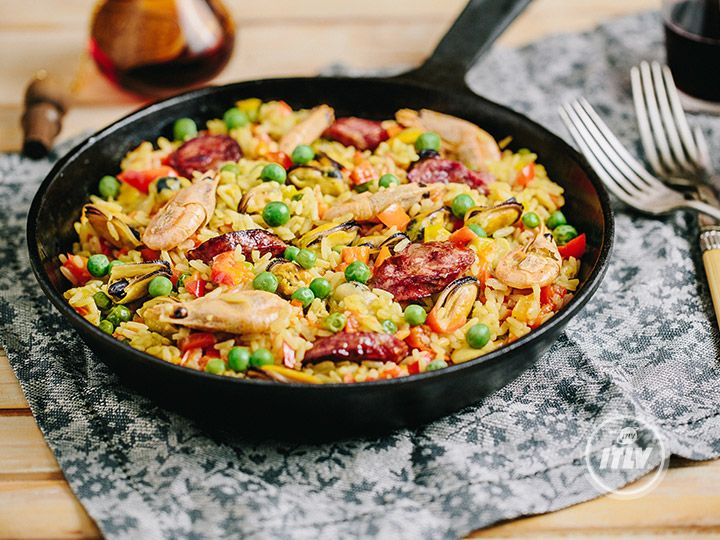
The name comes from the Latin word patella – “frying pan”.
Valencia is considered the birthplace of this dish, but in Spain you can already find more than 200 options for preparing paella.
Thursday is the long awaited “paella day” in Barcelona. On this day, most city restaurants serve paella for a business lunch (menú del dia). But why Thursday?
There is a version that this tradition did not come from the fishermen who brought fresh fish by Thursday and not from the cooks who cooked rice with leftover food, but from Francisco Franco himself!
Every Thursday, the stern dictator went out to the promenade, without warning, sat down to dine in a restaurant he liked and ordered only paella. The owners of all the restaurants in Madrid have started preparing paella on Thursdays in order to be ready for the unexpected arrival of the caudillos. The Spanish leader is no longer with us, and the Thursday paella tradition still exists in Madrid and Barcelona.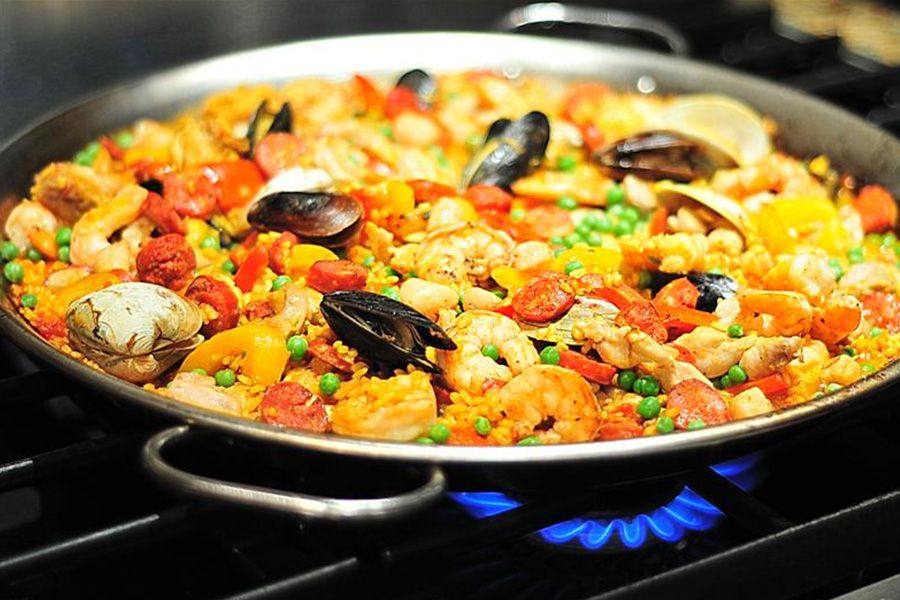
If on a normal day one serving of paella will cost you 15-20 euros, then on Thursday when ordering a business lunch you will get paella for the first, meat with a side dish for the second, as well as dessert and a drink. And all this for a single price of 10-12 euros. In general, now we especially love Thursday.
-
Spaniards eat paella for lunch, not for dinner. However, if you decide to treat yourself to paella in the evening, then keep in mind that the evening meal in Spain starts around 22.00 pm. Therefore, it is better to book a table in a restaurant for 20.00 – 20.30, as later it will be filled with locals, and earlier it will most likely be closed.
-
Paella prices on the menu are per person, but a good restaurant will serve paella for at least two people.
-
Since paella is traditionally eaten on Thursdays in Barcelona and Madrid, be aware that on this day, restaurants specializing in this dish are likely to be packed for both lunch and dinner.
Book a table in advance.
-
Soccarat is the name of the rice that is found at the bottom and barrels of the pan and is considered the most delicious and juicy part of the paella. You will most likely be given a special wooden spoon just for him. In some regions of Spain, there are even competitions among chefs in which not the paella itself is judged, but the most delicious “socorrat”.
-
Avoid restaurants with photos in tourist areas. Most likely they will serve you a frozen, tasteless copy of real paella.
-
The traditional bomba rice used in paella can be replaced with vermicelli and this will be called “fideua”. This traditional dish of Catalonia is no less tasty sister of paella.
-
You can learn how to cook paella and other colorful Spanish dishes at our daily master class led by a Spanish chef.
The best paella restaurants in Barcelona
Maná 75
This restaurant, located next to the W Hotel, will win you over at first sight.
Address: Passeig de Joan de Borbó, 101
Metro station: Barceloneta (M: L4)
Opening hours: Monday – Sunday 13:00-16:00;19:30-23:00
Marina Bay
This restaurant is located on the seafront and, in addition to an excellent variety of dishes, offers an excellent view of the coast. At Marina Bay on Thursdays, thanks to the inexpensive “menu del dia”, you can try magic paella at a budget price (when ordering a minimum of two). L4)
Working hours: Monday – Sunday 10:00-01:00
Would you like to go on a cool tour of Barcelona?
Xativa
This is not just a restaurant, but the so-called “rice” (L’arosseria) – an institution that for 25 years has been specializing in the preparation of rice and paella dishes, many of which are prepared with sea water.
The menu has a wide selection of vegetarian options.
Address No. 1: Carrer Torrent d’en vidalet, 26
Metro Station: Joanic (M:L4)
Address No. 3: Carrer Bordeus, 35
Metro Station: M: Entença (M:L1)
Monday – Sunday 13:00-00:00
Arume
This is a popular Galician restaurant, located in Raval, was created by four friends in love with Galician cuisine, led by Manu Nunez. In appearance, the tiny restaurant inside impresses with its chic, spacious and pleasantly decorated hall.
“We have Galician seafood, modern techniques, and spices from all over the world,” the smiling chef boastfully declares.
The building also has its own history: the Spanish writer Vasquez Montalbán used to live at Carrer Botella 13.
Address: Carrer Botella, 13,
Metro station: Sant Antoni (M: L4)
Opening hours: Monday – Sunday 13.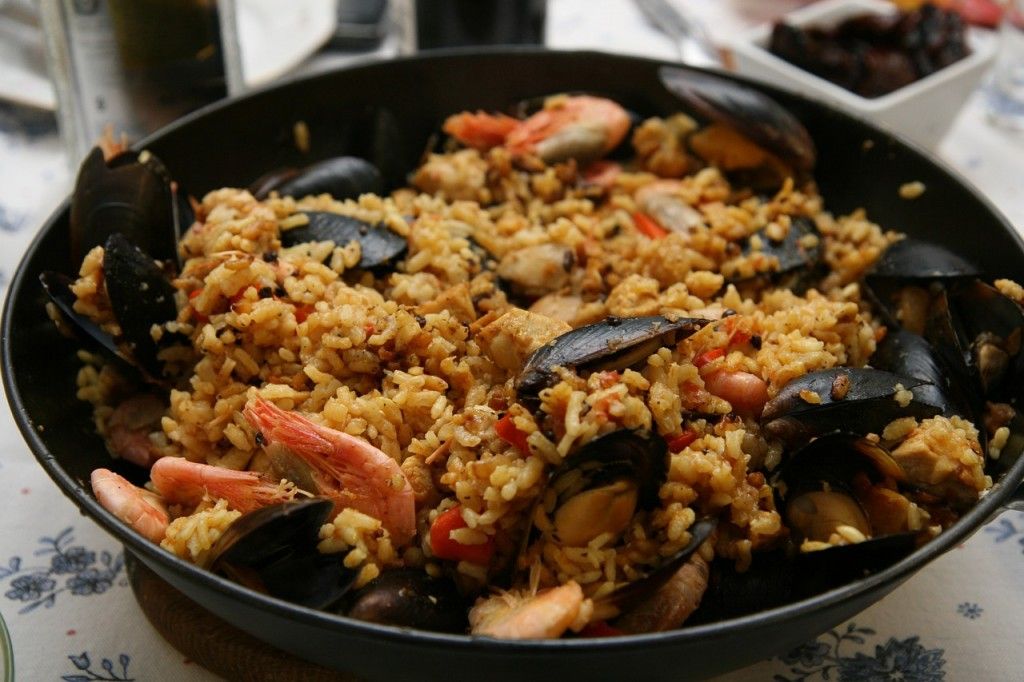
Taverna El Glop
“Taverna El Glop”, open since 1978 in the Gracia area. In addition to delicious paella and fideua, this restaurant offers a wide selection of meat and fish dishes.
We recommend that you book a table in advance, as the place is very popular with the locals.
Address: Carrer de Sant LLuís 24
Metro station: Joanic (M: L4)
Opening hours: Monday to Sunday from 13:00 to 00:00
L’ Àmfora
Fresh paella and seafood can be tasted not only in the coastal areas of Barcelona, but also in the Poble Sec area. In the Plaza de España area, L’ Àmfora is located – the “house of paella”, where you can find 14 types of paella. Critics say that it is so delicious here that even visiting Valencians who know the taste of real paella come here for it.
Address: Avinguda del Paral lel, 184
Metro: Poble Sec, Plaza España (M: L3)
Opening hours: Monday – Sunday 12:00-00:00
Tickets to Sagrada Familia
Can Majó
Can Majó is a family restaurant open since 1968.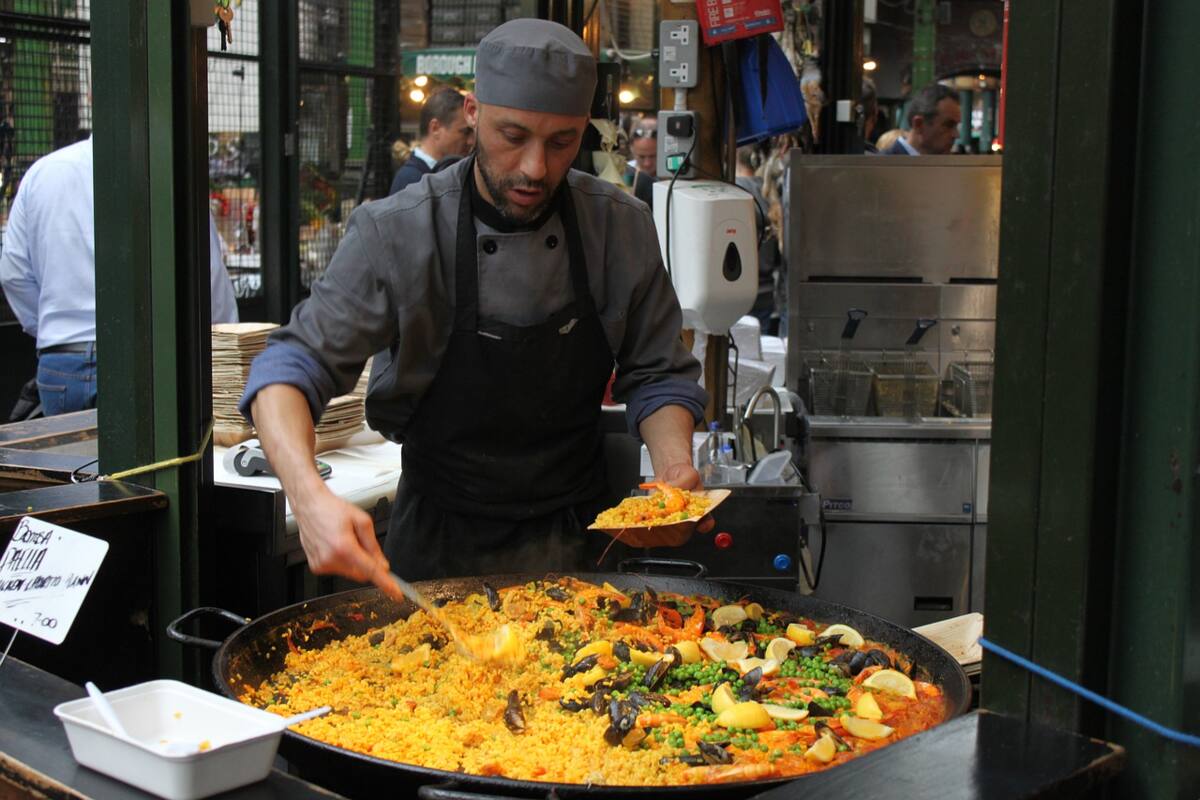
Enrique, the owner of the restaurant personally controls the freshness of the products purchased for the restaurant kitchen. He learned the fine art of selecting the best ingredients from his father, who was a local fisherman.
Address: Carrer de l’Almirall Aixada, 23, 08003 Barcelona
Metro station: Barceloneta(M: L4)
Opening hours: Tuesday – Saturday 13:00-16:00, 20:00-23:00
Sunday 13:00 00-16:00
7 Portes
One of the oldest restaurants in Barcelona.
Picasso is said to have been a regular in this classic Barcelona restaurant, opened in 1836. Named after the seven entrance doors, this restaurant is always included in all city tops as the best not only in terms of menu, but also in terms of interior and service. From the extensive menu, we highly recommend ordering the signature paella with rabbit and snails.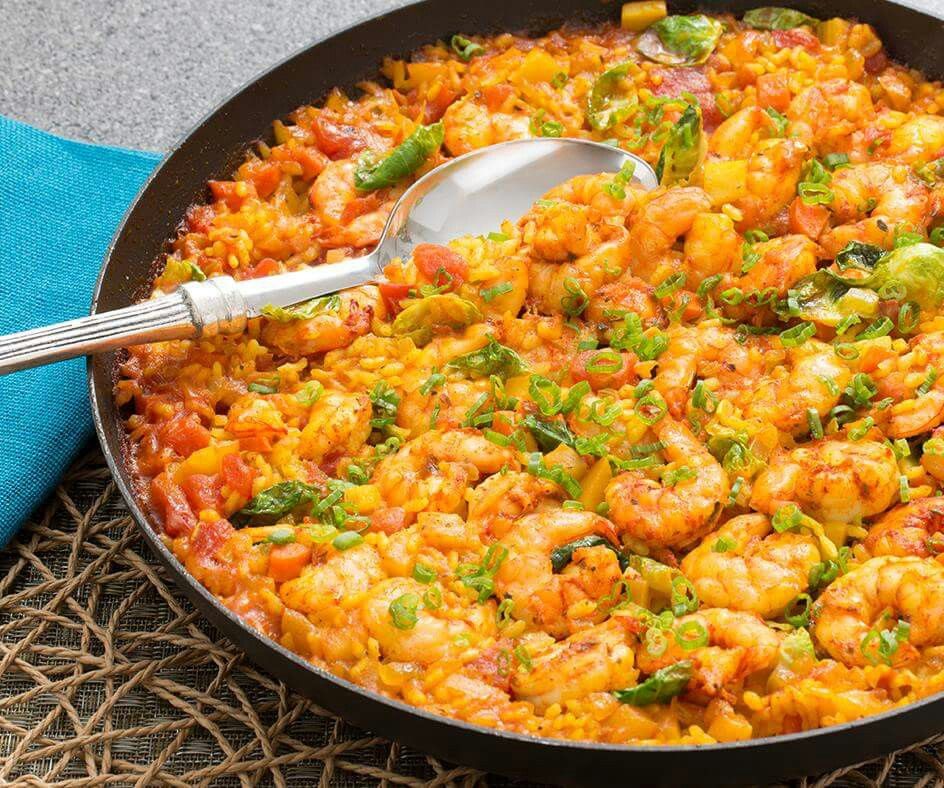
Address: Passeig d’Isabel II, 14, 08003 Barcelona
Metro station: Barceloneta (M: L4)
Opening hours: Monday – Sunday 13:00-01:00
Botafumeiro
Classic Catalan restaurant with lace tablecloths, waiters in white tunics and fresh flowers on the tables. This is the right place to not only taste delicious seafood and traditional dishes, but also feel the atmosphere of an authentic Barcelona dinner in the style of wealthy local bourgeois. Star guests of Barcelona, as a rule, treat in “Botafumeiro”.
Address: Carrer Gran de Gràcia, 81
Metro station: Fontana (M: L3)
Opening hours: Monday – Sunday 13:00-01:00
Would you like to see the legendary Barça at the Camp Nou stadium?
Terazza Martinez
If you are looking for a place that will please not only your stomach, but also your eyes, and no, I’m not talking about the handsome waiter Ricardo, then you should definitely look into the restaurant “Terazza Martinez”
In addition to author’s snacks, classic national dishes and a wide wine list, the special value of this institution is the view of Barcelona and its port part.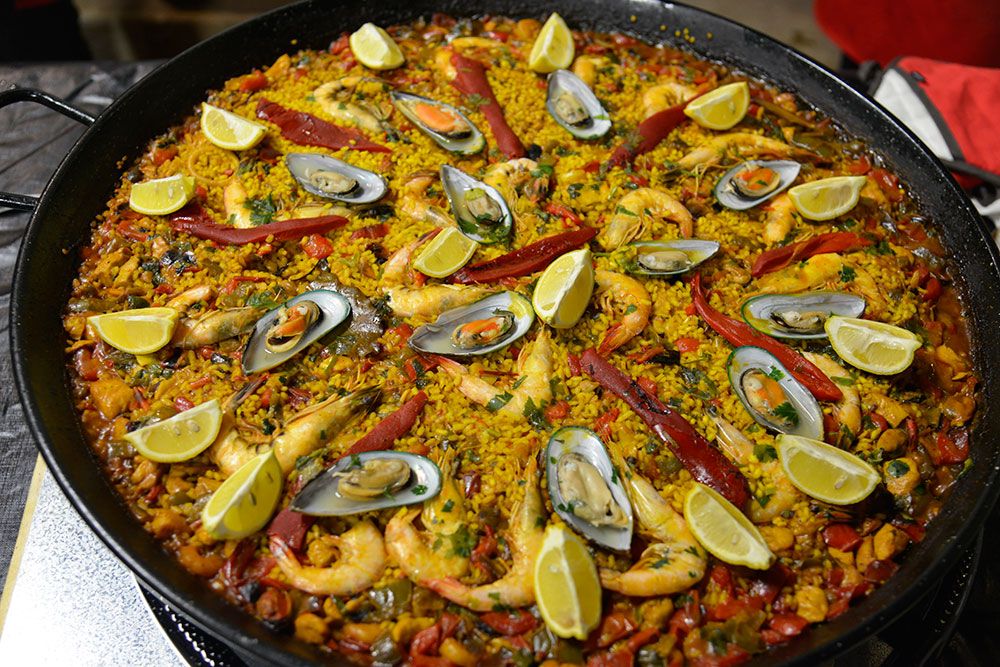
Book a table with a view in advance, order black rice with seafood, dine on signature desserts and remember that life is not only beautiful, but also delicious.
Address: Caretera de Miramar, 38
Opening hours: Monday – Saturday 19:00 – 02:00
Sunday: 17:00 – 02:00
Thank you for reading our articles. Follow us on social networks
About FUNBCN
My name is Alina Kabakova and I am the creator of the FUNBCN experience agency.
On our website you can find more than 50 exciting entertainment and services in Barcelona.
It’s time to relax in a new way! If a walk, then by the sea, if dinner, then on the roof, if flying, then by helicopter.
With us you will visit unknown places, get memories for a lifetime and save time and money.
Just write and we will create your dream holiday.
Featured Offers
Rooftop Dinner
Romantic Private Dinner with a View of Extraordinary Barcelona
Recent Blog Articles
Antonio Gaudí’s Masterpieces in Barcelona – FUNBCN
Activities in Barcelona and Catalonia – FUNBCN
Barcelona food – what to try in Barcelona? – FUNBCN
Choose a colorful holiday in Barcelona
Excursions
Entrance tickets
Romantic and extreme entertainment
| Write us |
Where to try the best pael in Ali cante.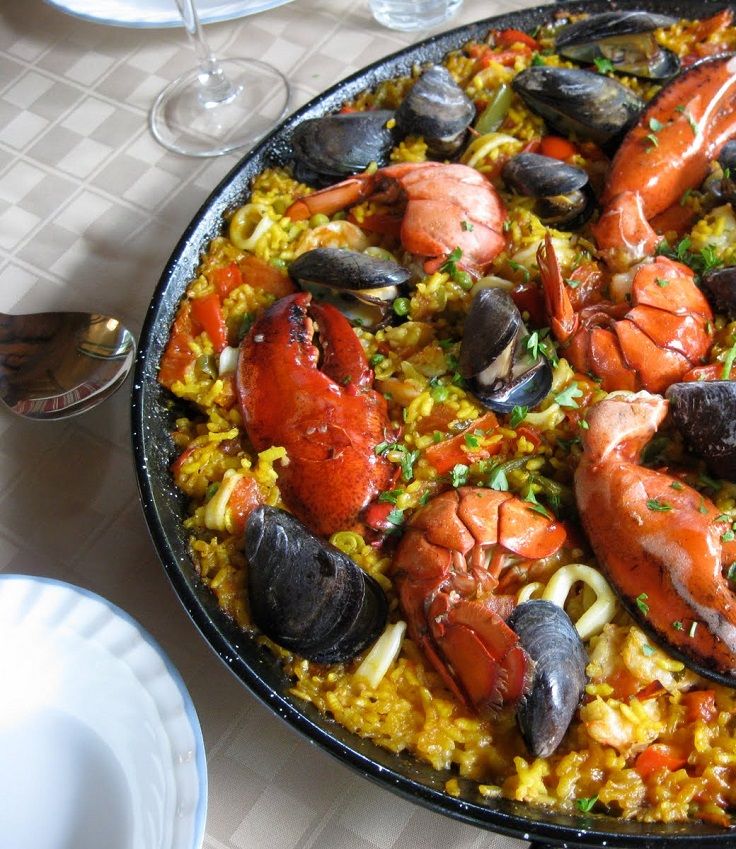
Subscribe to our newsletter and be the first to know about all offers
News
Many restaurants in the city of Alicante are grouped under the brand name Alicante Ciudad del Arroz. Keep in mind that not every establishment can receive this mark of excellence. Today we have collected the best of the best for you.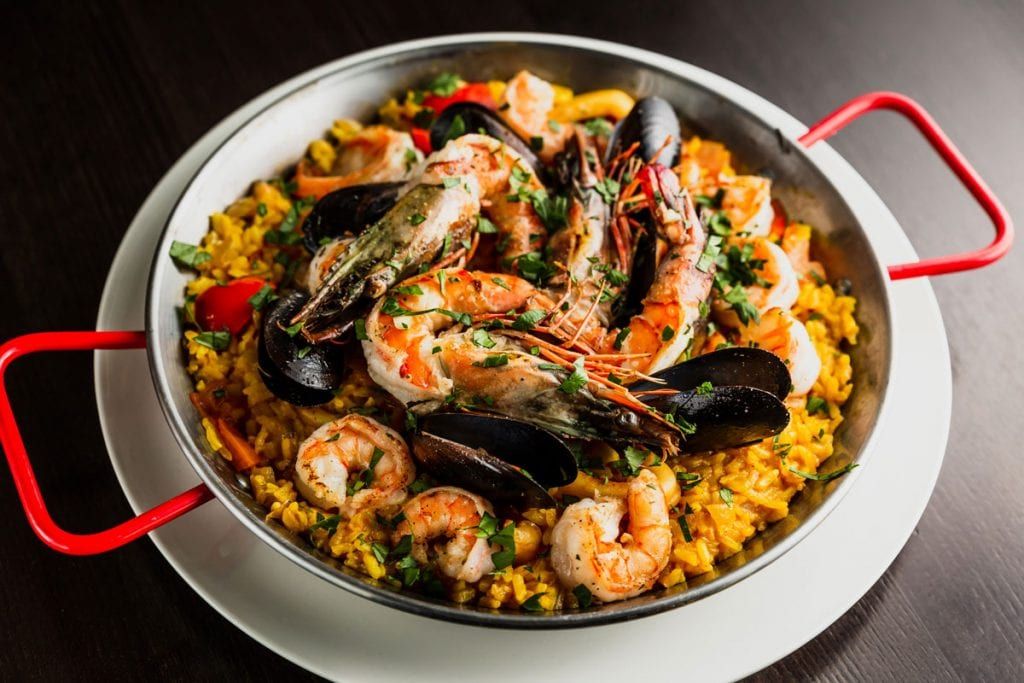
Casa Riquelme
For three decades, Moncho Riquelme has run a restaurant serving the best paella. This restaurant follows traditional recipes. The most favorite paella among visitors is the paella with tuna, shrimp and monkfish.
La Ereta
The people of Alicante say that this is the restaurant with the best views in the whole city. But not only they attract visitors to the gastronomic abode of Dani Frias, a chef who also relies on traditional recipes. But he also does not forget to experiment with tastes. How do you like paella with octopus, potatoes and alioli sauce?
La Sastrería
Having lived in countries such as China, Turkey, Greece and Russia, Maria Luisa Rivera decided to return to Alicante to open a restaurant. She made it exactly as she dreamed: small, cozy, with an individual approach and care for the environment. Even the most avid gourmets find paella here to their taste.
Maestral
This beautiful restaurant is located in a chalet with a garden, just a few meters from Playa de la Albufereta beach. The glory of their traditional dish was brought by the rice master Francisco Jose Garcia Linares. “The key to success is that we use the freshest produce in our area. Fish and seafood are brought daily from neighboring fish markets, and we order vegetables and meat from farmers we know,” the restaurant says.
Pocardy
This restaurant is the personal merit of Gonzalo Bonet, director of the Hotel Almirante, who five years ago put all his efforts into creating a gastronomic corner on the first line of Playa de San Juan. The kitchen, led by Chef Guillermo Severa, prepares paella of all kinds, both traditional and unusual, such as crispy suckling pig ears.
Where did you try the best paella in your life?
Follow Spain’s news on our Instagram profile @ espanarusa.


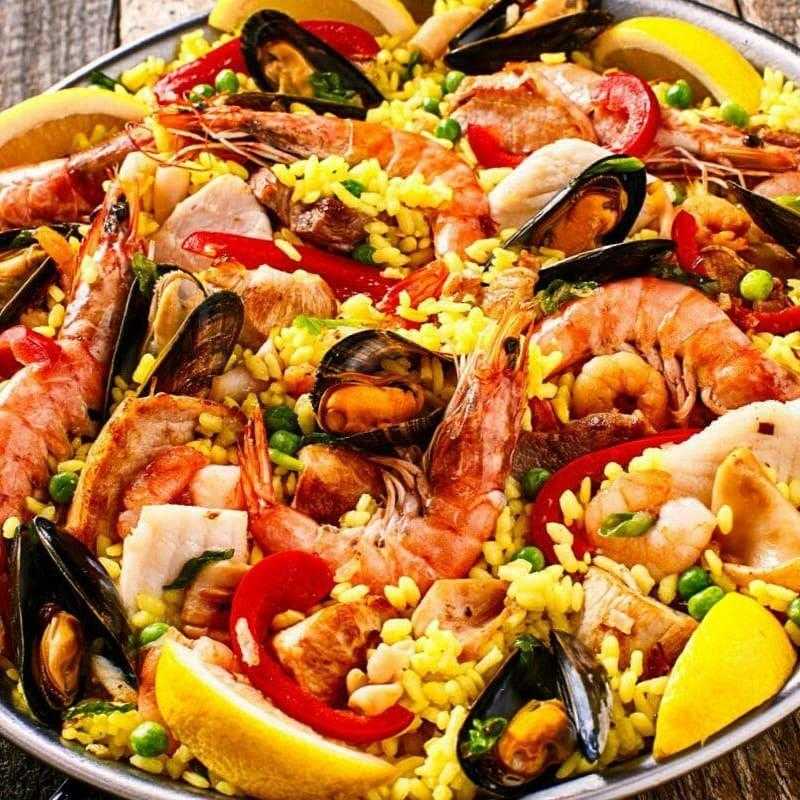 (Long grain rice or arborio rice are not good substitutes for paella.)
(Long grain rice or arborio rice are not good substitutes for paella.)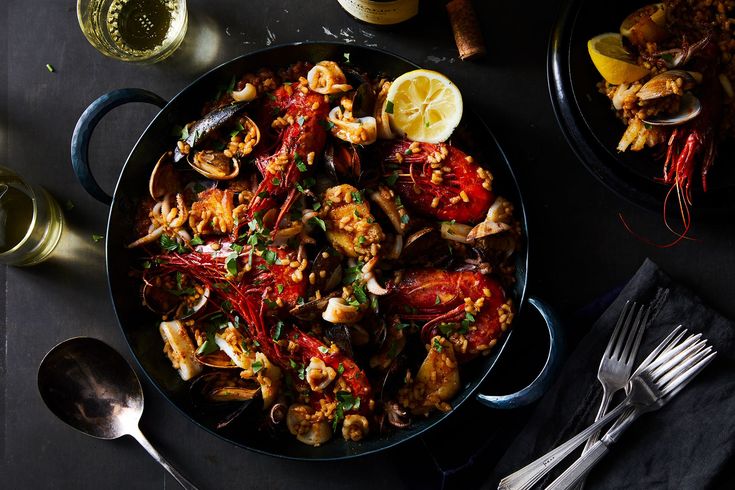
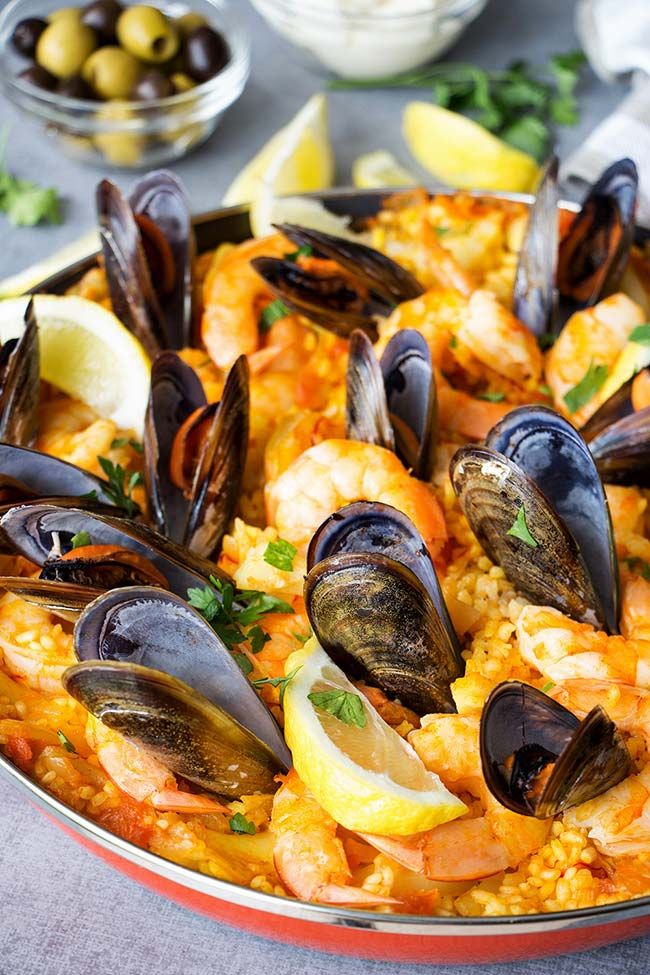 tomato sauce)
tomato sauce)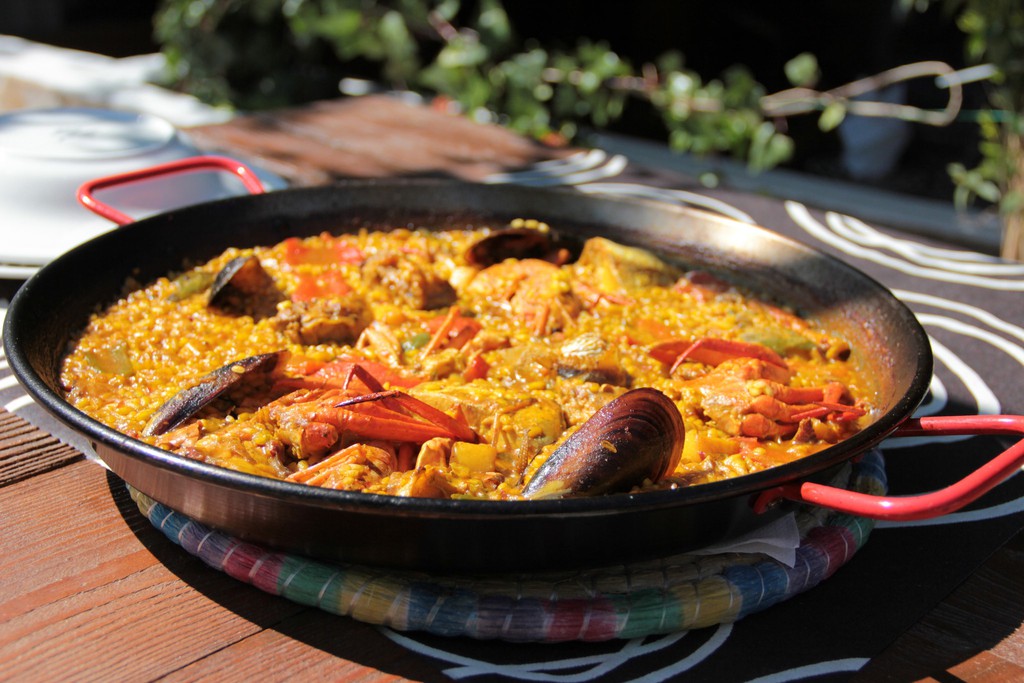 There are MANY variations to Paella so please be respectful that my authentic recipe may be different from yours!
There are MANY variations to Paella so please be respectful that my authentic recipe may be different from yours! Watch for most of the liquid to be absorbed and the rice at the top nearly tender. (If for some reason your rice is still not cooked, add ¼ cup more water or broth and continue cooking).
Watch for most of the liquid to be absorbed and the rice at the top nearly tender. (If for some reason your rice is still not cooked, add ¼ cup more water or broth and continue cooking).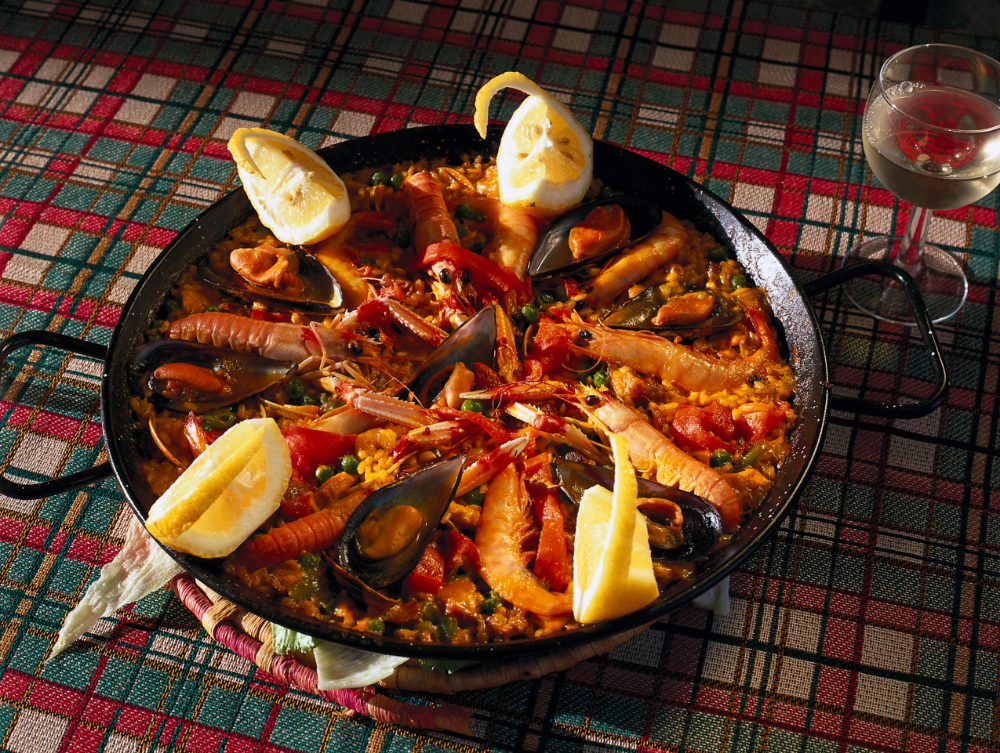 Add the meat back to the pan in step 3 of the recipe, before boiling.
Add the meat back to the pan in step 3 of the recipe, before boiling.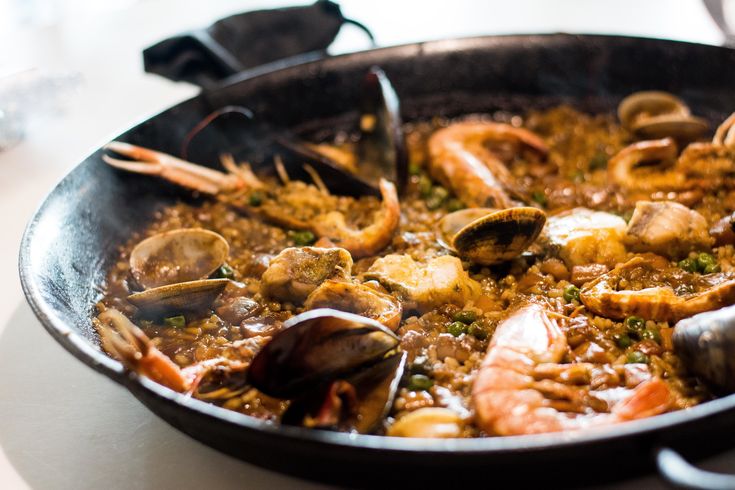 Let everything come to a simmer and cook, uncovered until the rice absorbs almost all the liquid.
Let everything come to a simmer and cook, uncovered until the rice absorbs almost all the liquid.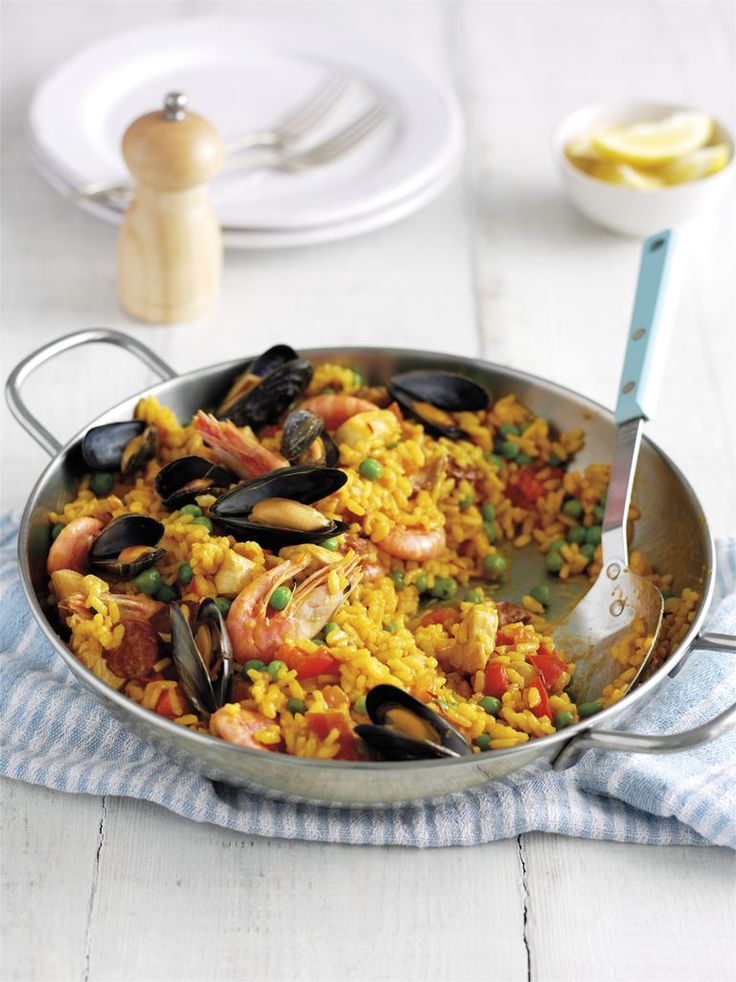
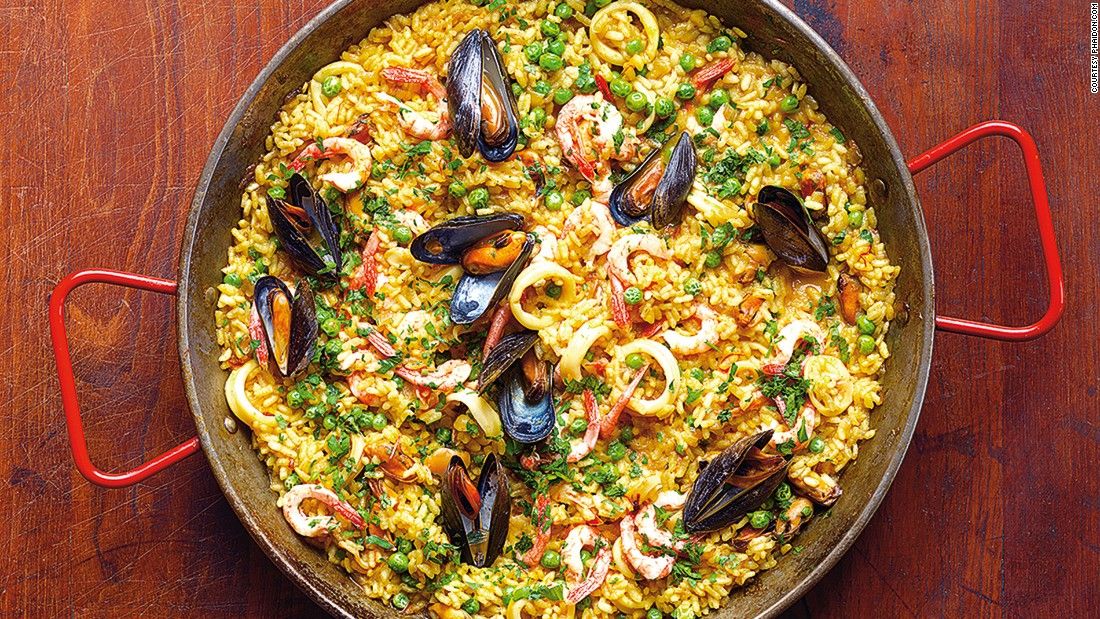 5 cups bomba rice
5 cups bomba rice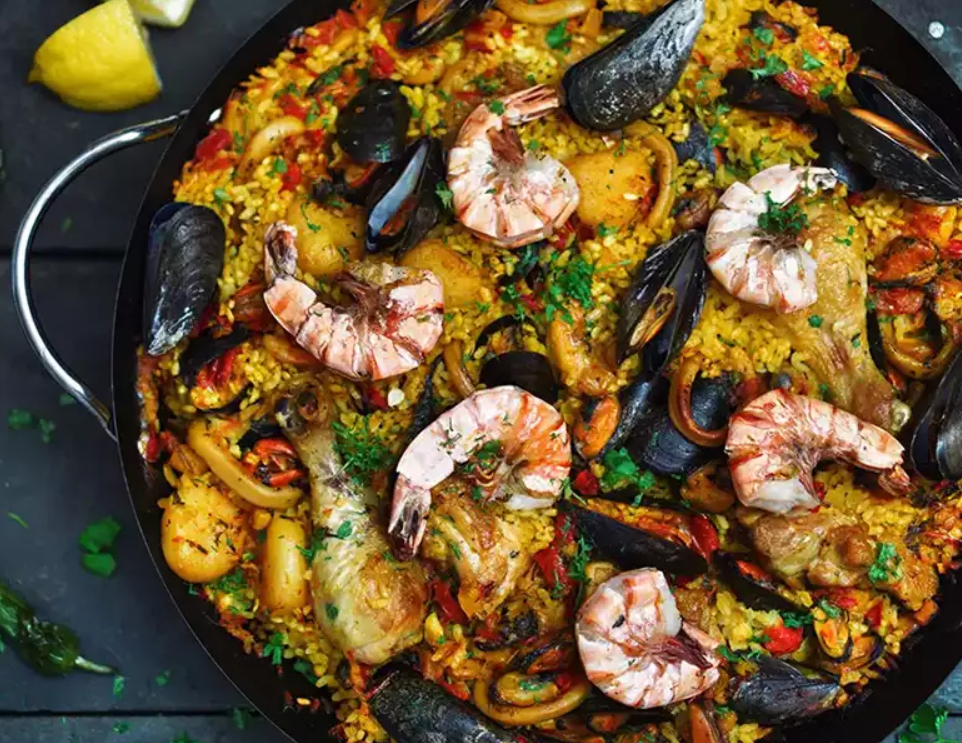 If the pan is larger than the burner, rotate it every two minutes to evenly distribute the heat. Once the stock is low enough, add the remaining 2 cups chicken stock.
If the pan is larger than the burner, rotate it every two minutes to evenly distribute the heat. Once the stock is low enough, add the remaining 2 cups chicken stock.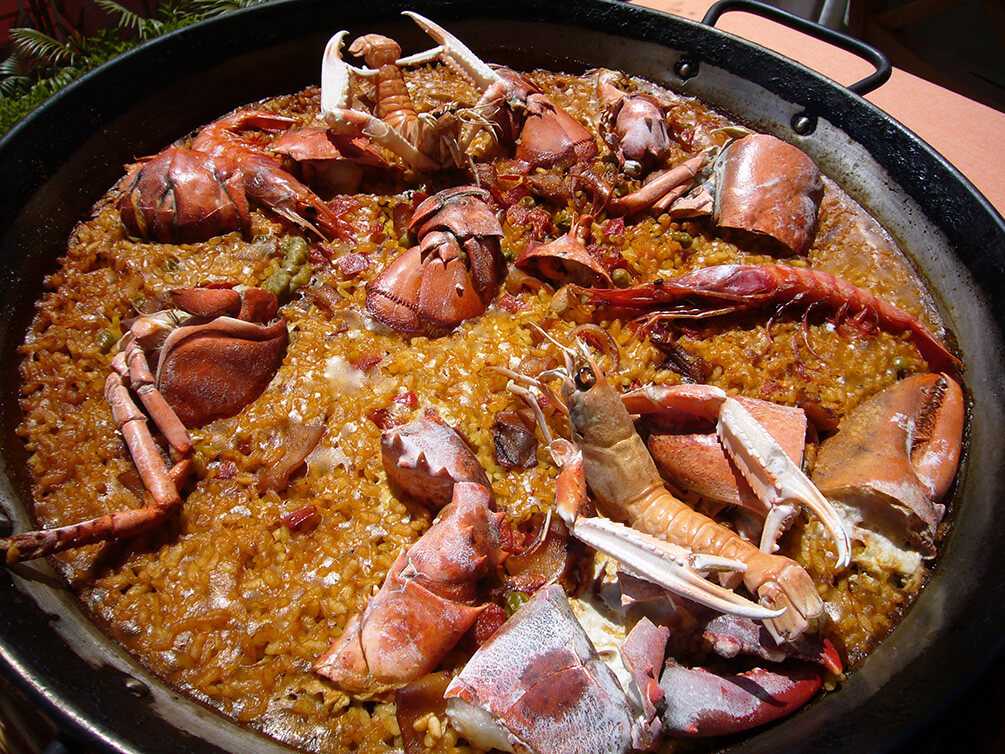 Book a table in advance.
Book a table in advance. 